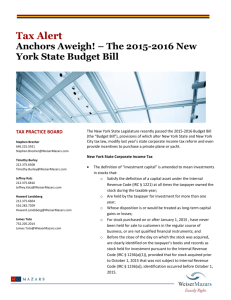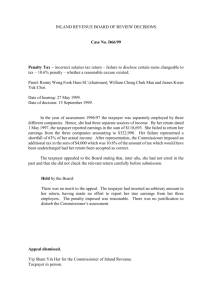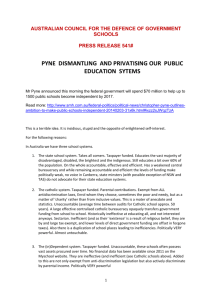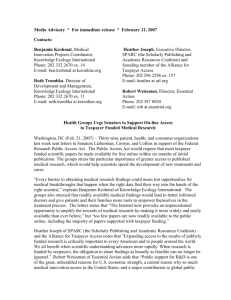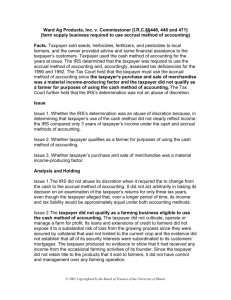An Honest Cheat Sheet Spending and taxes Teachers and Students
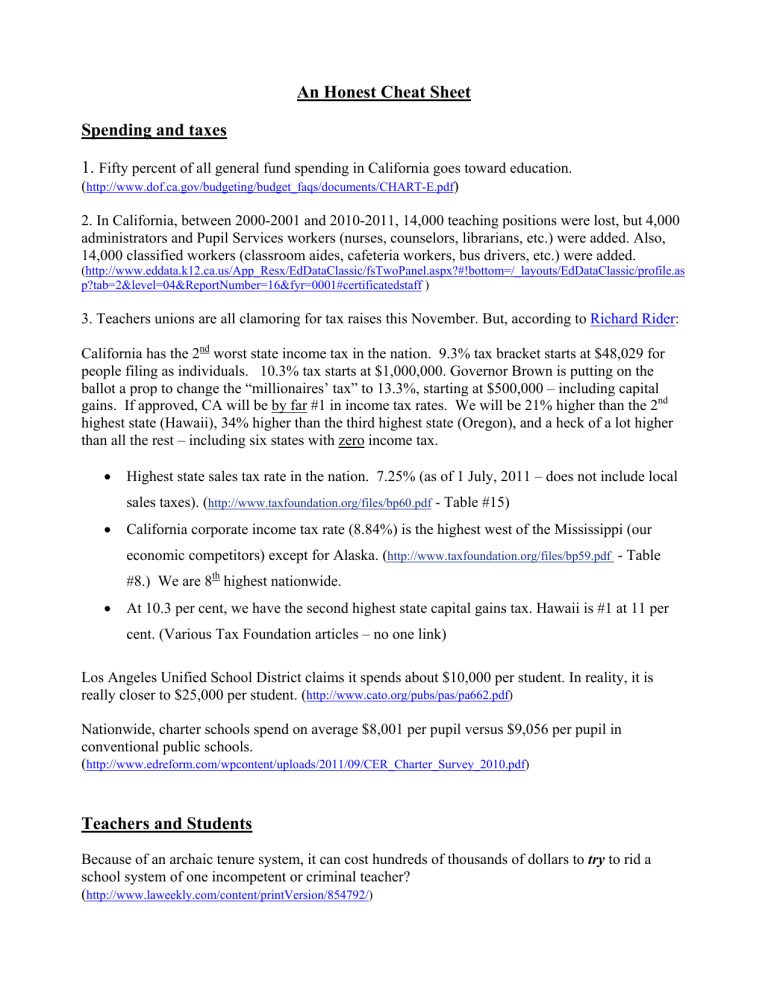
An Honest Cheat Sheet
Spending and taxes
1. Fifty percent of all general fund spending in California goes toward education.
( http://www.dof.ca.gov/budgeting/budget_faqs/documents/CHART-E.pdf
)
2. In California, between 2000-2001 and 2010-2011, 14,000 teaching positions were lost, but 4,000 administrators and Pupil Services workers (nurses, counselors, librarians, etc.) were added. Also,
14,000 classified workers (classroom aides, cafeteria workers, bus drivers, etc.) were added.
( http://www.eddata.k12.ca.us/App_Resx/EdDataClassic/fsTwoPanel.aspx?#!bottom=/_layouts/EdDataClassic/profile.as
p?tab=2&level=04&ReportNumber=16&fyr=0001#certificatedstaff )
3. Teachers unions are all clamoring for tax raises this November. But, according to Richard Rider :
California has the 2 nd
worst state income tax in the nation. 9.3% tax bracket starts at $48,029 for people filing as individuals. 10.3% tax starts at $1,000,000. Governor Brown is putting on the ballot a prop to change the “millionaires’ tax” to 13.3%, starting at $500,000 – including capital gains. If approved, CA will be by far #1 in income tax rates. We will be 21% higher than the 2 nd highest state (Hawaii), 34% higher than the third highest state (Oregon), and a heck of a lot higher than all the rest – including six states with zero income tax.
•
Highest state sales tax rate in the nation. 7.25% (as of 1 July, 2011 – does not include local sales taxes). ( http://www.taxfoundation.org/files/bp60.pdf
- Table #15)
•
California corporate income tax rate (8.84%) is the highest west of the Mississippi (our economic competitors) except for Alaska. ( http://www.taxfoundation.org/files/bp59.pdf
- Table
#8.) We are 8 th
highest nationwide.
•
At 10.3 per cent, we have the second highest state capital gains tax. Hawaii is #1 at 11 per cent. (Various Tax Foundation articles – no one link)
Los Angeles Unified School District claims it spends about $10,000 per student. In reality, it is really closer to $25,000 per student. ( http://www.cato.org/pubs/pas/pa662.pdf
)
Nationwide, charter schools spend on average $8,001 per pupil versus $9,056 per pupil in conventional public schools.
( http://www.edreform.com/wpcontent/uploads/2011/09/CER_Charter_Survey_2010.pdf
)
Teachers and Students
Because of an archaic tenure system, it can cost hundreds of thousands of dollars to try to rid a school system of one incompetent or criminal teacher?
( http://www.laweekly.com/content/printVersion/854792/ )
The average teacher’s annual salary in California is $67,448, the highest in the country.
( http://www.eddata.k12.ca.us/App_Resx/EdDataClassic/fsTwoPanel.aspx?#!bottom=/_layouts/EdDataClassic/fiscal/Te acherSalary.asp?reportNumber=4096&level=06 ) That is for 180 days work, but does not include the teacher’s health plan and a state pension plan.
Nationwide, CA students rank 48 th
in math achievement, 49 th
in reading.
( http://www.lao.ca.gov/reports/2011/calfacts/calfacts_010511.aspx
- page 36.)
Teachers in CA do not pay into the Social Security System, but they do pay into the state teacher retirement system. They pay 8 percent of each paycheck. But since the taxpayer pays the teachers, it is the taxpayer who pays this portion of the teacher’s pension. The “employer” then contributes another 8.25 percent. The employer of course is the school district which receives its funding from the taxpayer. The state (again the taxpayers) kicks in another 2.017 percent.
( http://ctainvest.org/home/CalSTRS-CalPERS/about-calstrs/calstrs-retirement-benefit.aspx
) So it is the taxpayer who is paying for the whole thing. The taxpayer will pay one more time because the system is unsustainable unless the stock market doubles about every 9 years.
Teachers can pad their pay by taking useless “professional development” classes that can “earn” them an extra million dollars in their careers and retirement? http://www.nctq.org/tr3/docs/nctq_salary_combo.pdf
When teachers in CA retire, they can cash in any sick time they have not used. (Teachers typically get about ten sick days per year.) This means that if a teacher works for 30 years and retires with
180 unused sick days, they are credited with having taught 31 years. (180 days equals one full school year.) ( http://www.calstrs.com/calculators/retbencalc.aspx
)
The California statewide dropout rate in 2009 was 33.7 percent.
( http://www.cpeconline.org/33130_CPEC_ReportOne_PROOF03.pdf
)
Of those who graduate and go on to college, 30 percent of entering University of California students need remediation. Sixty percent of Cal State students need remediation and 90 percent of students entering the state’s community colleges need remediation. ( http://www.pacificresearch.org/publications/thecosts-of-californias-promote-now-pay-later-plan )
From Professor Jay Greene: “The average ed school, we found, has a multiculturalism-to-math ratio of 1.82, meaning that it offers 82 percent more courses featuring social goals than featuring math.
At Harvard and Stanford, the ratio is about 2: almost twice as many courses are social as mathematical. At the University of Minnesota, the ratio is higher than 12. And at UCLA, a whopping 47 course titles and descriptions contain the word ‘multiculturalism’ or ‘diversity,’ while only three contain the word ‘math,’ giving it a ratio of almost 16.” ( http://www.cityjournal.org/2008/18_1_snd-ed_schools.html
)
It has been estimated that 5 to 7 percent of teachers should not be employed as teachers. In CA, there are about 300,000 teachers. If we use the lower number – 5 percent – that means that there are
15,000 teachers who shouldn’t be in the classroom. If each of these teachers has 20 kids in their class, that means 300,000 kids a year are getting an inferior education. (This is only counting elementary teachers. Middle and high school teachers have more students, thus can inflict more damage.) According to Eric Hanushek, “Assuming the upper-bound estimate of teachers’ impact,
U.S achievement could reach that in Canada and Finland if we replaced with average teachers the least effective 5 to 7 percent of teachers, respectively. Assuming the lower-bound estimate of teachers’ impact, U.S achievement could reach that in Canada and Finland if we replaced with average teachers the least effective 8 to 12 percent of teachers, respectively.”
( http://educationnext.org/valuing-teachers/ )
The Teachers Unions
Every teacher contract in the state has a provision whereby teachers who are union representatives get classroom time off each month to do union business? Sometimes the union pays for the sub, but in any event, the union rep is being paid by the taxpayer to do union business on school time.
( http://webcache.googleusercontent.com/search?q=cache:AbPzT8sX7KcJ:www.perb.ca.gov/forms_pubs/RulingsSumm ary.asp+teacher+union+release+time+in+ca&cd=2&hl=en&ct=clnk&gl=us&client=firefox-a )
It is the taxpayer-supported school district, not the teachers unions, that collects the union dues that teachers are forced to pay in this state. ( http://www.ctenhome.org/knowMembership.htm
)
In 2010-2011, The National Education Association collected $399 million in dues and spent $133 million on candidates and gifts. ( http://rishawnbiddle.org/outsidereports/nea_dol_filing_2011.pdf
)
National Education Association and state affiliate revenues for 2008-09 were over $1.5 billion. No taxes were paid on any of this money. ( http://www.eiaonline.com/NEAandStateAffiliateFinances2008-09.htm
)
The California Teachers Association took in over $186 million in 2010 and paid no taxes. http://www2.guidestar.org/FinDocuments/2010/940/362/2010-940362310-075adf77-9O.pdf
CTA spent over $211 million on politics in 2000-2009, by far the biggest political spender in the state.
( http://www.fppc.ca.gov/reports/Report31110.pdf
)
CTA spent 6.57 million on lobbying in 2011 – the most in the state.
( http://www.sacbee.com/2012/02/02/v-wireless/4232988/spending-on-lobbying-sets-record.html
)
CTA President Dean Vogel’s yearly compensation is almost $300,000.
( http://www2.guidestar.org/FinDocuments/2010/940/362/2010-940362310-075adf77-9O.pdf
)
New Jersey Education Association President Vince Giordano’s yearly compensation is almost
$500,000. ( http://www2.guidestar.org/FinDocuments/2010/210/524/2010-210524390-075ae114-9O.pdf
)
In 2008, Reg Weaver’s last year as NEA President he made over $600,000 in total compensation
( http://richgibson.com/neaSALARY.html
)
Now retired, much of Weaver’s $242,000 pension is paid by taxpayers.
( http://articles.chicagotribune.com/2011-10-23/news/ct-met-pensions-teacher-side-20111023_1_state-pension-pensionlaw-state-teachers )





